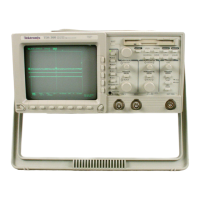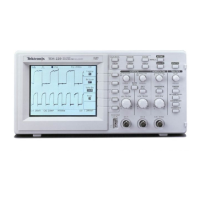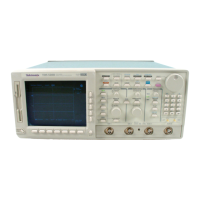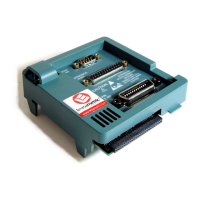Specifications
TDS 340A, TDS 360 & TDS 380 Technical Reference
1–5
Typical Characteristics
Typical characteristics are described in terms of typical or average performance.
Typical characteristics are not warranted.
Table 1–6: Typical characteristics — signal acquisition system
Name Description
Accuracy, DC Gain, Envelope
Acquisition Mode
±3% for sec/div settings from 5 Sec/Div to 25 sec/div;
±2% for sec/div settings from 10 s/div to 5 ns/div (TDS 340A);
±2% for sec/div settings from 10 s/div to 2.5 ns/div (TDS 360);
±2% for sec/div settings from 10 s/div to 1 ns/div (TDS 380)
u
a
y, DC V
ag
M
a
u
n
,
Measurement type DC accuracy
Sa
p
qu
n M
d
Any Sample ±(2.0% × (|reading – Net Offset
1
|) + Offset
Accuracy + 0.13 div + 0.6 mV)
Delta Volts between any two samples
2
acquired under the same setup and
ambient conditions
±(2.0% × |reading| + 0.26 div + 1.2 mV)
Frequency Limit, Upper, 20 MHz Band-
width Limited
20 MHz
S
p R
p
n
S
ng E
Vo
ts/
t
Settling error (%)
3
s
tt
n
m
t
100 ns 20 ms
2 mV/div – 99.5 mV/div ≤2 V ≤1.0 ≤0.1
100 mV/div – 995 mV/div ≤20 V ≤1.5 ≤0.2
1 V/div – 10 V/div ≤200 V ≤2.5 ≤0.2
Common Mode Rejection Ratio (CMRR) 100:1 at 60 Hz, reducing to 20:1 at 50 MHz, with equal Volts/Div and Coupling settings
on each channel.
1
Net Offset = Offset – (Position × Volts/Div). Net Offset is the voltage level at the center of the A-D converter dynamic
range. Offset Accuracy is the accuracy of this voltage level.
2
The samples must be acquired under the same setup and ambient conditions.
3
The values given are the maximum absolute difference between the value at the end of a specified time interval after the
mid-level crossing of the step, and the value one second after the mid-level crossing of the step, expressed as a
percentage of the step amplitude.

